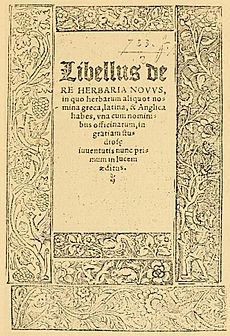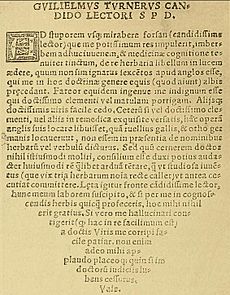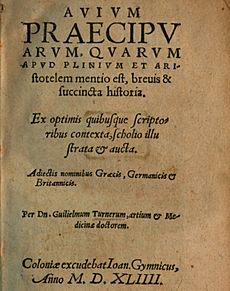William Turner (naturalist) facts for kids
William Turner (born around 1509, died 1568) was an English doctor, religious leader, and a great student of nature. Many people call him "The father of English botany" because of his important work with plants. He studied medicine in Italy and was friends with Conrad Gessner, a famous Swiss naturalist.
Turner was one of the first "parson-naturalists" in England. This means he was both a religious leader and someone who studied nature. He was very interested in plants and birds. His work in these areas is still very important today.
He first wrote a book called Libellus de Re herbaria in Latin in 1538. Later, he translated it into English. He believed that people who knew about plants should share their knowledge more widely. Some of his books were banned by kings and queens like Henry VIII and Mary I of England.
Contents
About William Turner
His Early Life and Studies
William Turner was born in Morpeth, Northumberland, England, around 1508. His father was likely a tanner, someone who prepares animal hides.
Turner went to Pembroke Hall at Cambridge University. He studied there from 1526 to 1533. He earned his first degree (B.A.) in 1530 and his master's degree (M.A.) in 1533. While at Cambridge, he published some of his early works. This included Libellus de re herbaria in 1538.
During his free time at Cambridge, Turner loved to study plants. He would search for them in their natural homes. He described them very carefully, which was new for England at that time.
Around 1540, Turner started traveling and giving religious talks. He was arrested for a short time. After he was released, he went to Italy to study medicine. He studied in Ferrara and Bologna from 1540 to 1542. He earned his medical degree there. He married Jane Auder, and they had a son named Peter in 1542.
His Career and Later Life
After finishing his medical degree, Turner became a doctor for an important leader called the Earl of Emden. When he returned to England, he became a religious advisor and doctor to the Duke of Somerset. This helped him get important jobs in the church. He also became a doctor for many wealthy people.
In 1551, he became the Dean of Wells Cathedral. There, he started a special garden for herbs. When Mary I of England became queen, Turner had to leave England again. This was because of his religious beliefs. From 1553 to 1558, he lived in Germany and worked as a doctor. During this time, he became a Calvinist, a type of Protestant.
When Elizabeth I of England became queen in 1558, Turner came back to England. He was again the Dean of Wells Cathedral from 1560 to 1564. He tried to make the English church more like the reformed churches in Germany and Switzerland. This led to him being suspended from his job in 1564.
William Turner died in London on July 7, 1568. He was buried in the church of St Olave Hart Street. A stone there remembers him.
His Important Books
Early in his career, Turner became very interested in nature. He wanted to make accurate lists of English plants and animals. He published Libellus de re herbaria in 1538.
In 1544, Turner published Avium praecipuarum, quarum apud Plinium et Aristotelem mentio est, brevis et succincta historia. This long title means "A short and accurate history of the principal birds mentioned by Pliny and Aristotle." This book was very special. It not only talked about birds mentioned by ancient writers but also added Turner's own detailed descriptions. He wrote about the lives of birds based on his own observations. This was the first printed book ever written entirely about birds.
In 1551, he published the first part of his most famous work, his Herbal. This book is why he is known as a great botanist.
His A new herball, wherin are conteyned the names of herbes… was a huge project. The first part came out in London in 1551. The second part was published in 1562, and the third in 1568. These books were the first clear and organized study of English plants. They had beautiful woodcut pictures, mostly copied from another famous book by Leonhart Fuchs. Turner's books also included his own careful observations from studying plants in nature.
Turner's Herbal also described how plants could be used and their "vertues" (healing properties). He knew some people might think he was sharing too much information with everyone. But for the first time, people in England could easily identify common English plants using a book written in their own language.
He also wrote other books, like A New Book of Spiritual Physick (1555). In 1568, he published A New Boke on the Natures and Properties of all Wines. This book also had medical purposes.
Turner's studies of nature sometimes had political meaning. For example, he spoke out against a rule by King Henry VIII. The king said only rich men could read the Bible. Turner asked why rich people should be considered wiser than poor people.
Turner also believed in the idea of the transmutation of species. This means he thought that different kinds of living things could change over time. A historian of science, Charles E. Raven, said that Turner, who was a very good observer, thought this change was a common event in nature.
His Natural History Books
- 1538: Libellus de re herbaria novus. This was his first book about herbs.
- 1544: Avium praecipuarum, quarum apud Plinium et Aristotelem mentio est, brevis et succincta historia. This was his groundbreaking book about birds.
- 1551, 1562, 1568: A new herball, wherin are conteyned the names of herbes…. This was his famous three-part work on English plants.
See also
 In Spanish: William Turner para niños
In Spanish: William Turner para niños





